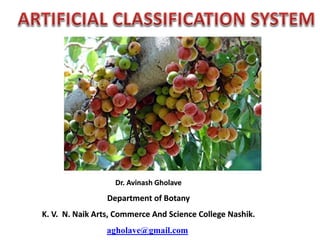
Artificial system of classification
- 1. Dr. Avinash Gholave Department of Botany K. V. N. Naik Arts, Commerce And Science College Nashik. agholave@gmail.com
- 2. Definition: “The arrangement of plants into groups and sub-groups on the basis of similarities is called classification. The characters which are uses as basis of classification are called criteria of classification.” TYPES: 1. Artificial system of classification 2. Natural system of classification 3. Phylogenetic system of classification 1. Artificial system of classification: “The classification system based only one or two morphological characters for the identification of plants is called artificial classification system.”
- 3. In artificial system of classification, plants are classified on the basis of one or very few specially choosen characters. 1. Theophrastus: divided the plants on the basis of form and texture – Herbs, Shrubs, Under shrubs and Trees. He gave names and description to about 480 plants in his book ‘Historia plantarum’ which is the oldest botanical work in existence. 2. John Ray: a British botanist divided plants into Imperfectae (non- flowering) and Perfectea (seed- plants). 3. Carolus Linnaeus: regarded as the “Father of Systematic Botany”‘, published artificial system based exclusively on floral characters. Carolus Linnaeus John Ray Theophrastus:
- 4. CLASSIFICATION SYSTEM OF CARLOUS LINNAEUS: The classification system of Linnaeus was based on floral characters. He chiefly used characters of stamens. Therefore, his system is called sexual system. This system is very convenient for the identification of plants . He presented his classification system into two books. 1. Species Plantarun 2. Genera Plantarum He formed 24 classes of plants on the basis characters of stamens, he placed many unrelated plants in a single group due to common characters of stamens.
- 5. He also used the condition of perigynous, hypogynous, dynamous, filaments fused or not, anther attachment, presence of male and female flowers. Dynamous
- 6. A. Monodria (flower with 1 stamen) B. Diandria (flower with 2 stamens) C. Triandra (flower with 3 stamens) D. Tetrandria (flower with 4 stamens)
- 7. E. Pentrandria (flower with 5 stamens) F. Hexandria (flower with 6 stamens) G. Heptandria (flower with 7 stamens) H. Octandria (flower with 8 stamens)
- 8. I. Enneandria (flower with 9 stamens) K. Decandria (flower with 10 stamens) L. Dodecandria (flowers with 12 stamens) M. Icosandria (flowers with more than 20 stamens are attached to the calyx).
- 9. N. Polyandria (flowers with more than 20 stamens are attached to the receptacle). O. Didynamia (Stamens didynamous) P. Tetradynamia (stamens tetradynamous) Q. Monadelphia (fused stamens monadelphous)
- 10. R. Diadelphia (stamens diadelphous) S. Polyadelphia (stamens polyadelphous) T. Syngenesia (stamens syngenesious) U. Gynandria (stamens fused to their pistil)
- 11. V. Monoacia (they have male and female flowers on same plants) X. Dioecia (they have male and female flowers on distinct plants) Y. Polygamia (having male, female, and bisexual flowers on the same plant) Z. Cryptogamia (non -flowering plants i. e, cryptogams which include algae, fungi, mosses and ferns)
- 12. MERITS : 1. Linnaeus was first who introduced some system of classification. 2. It gave some basic knowledge of classification. So it was widely accepted by the taxonomist of that time. 3. It provided a reference work. He gave clear cut concept of species. This system is still used today. 4. It is the quick and easy identification of plants based on one or a few characteristics.
- 13. DEMERITS: 1. Only a few characters are considered 2. Members of different groups are usually not similar in hereditary pattern 3. Stable classification system 4. Provide only limited information 5. Cannot add new work 6. Difficult for identifying a particular specie or genera 7. Not related phylogenetically
